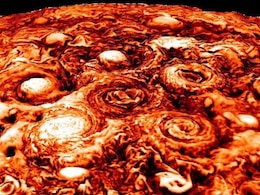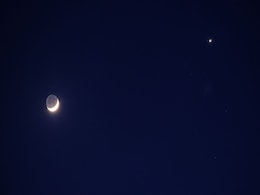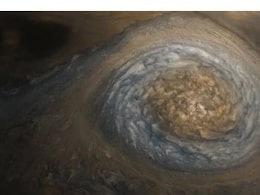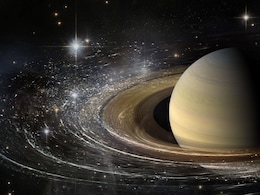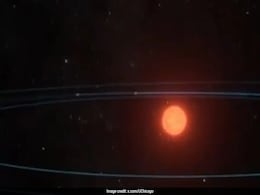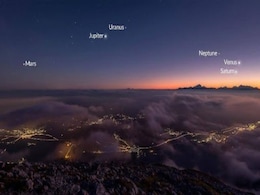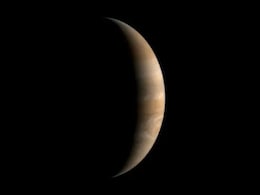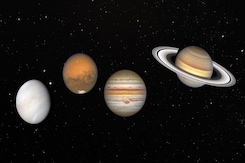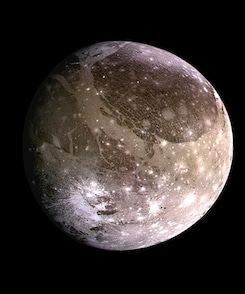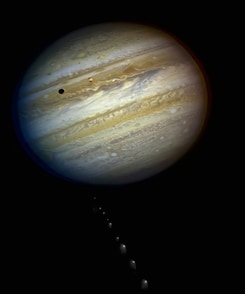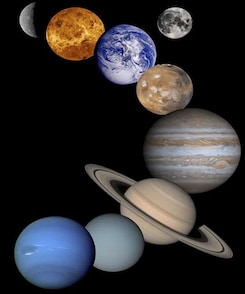Jupiter
- All
- News
- Videos
- Photos
- Web Stories
-

Juno Mission Sheds Light on Jupiter’s Storms and Volcanic Activity on Io
- Friday May 2, 2025
- Written by Gadgets 360 Staff
NASA’s Juno probe has uncovered colliding cyclones circling Jupiter’s north pole and flowing magma beneath the crust of its volcanic moon Io. Using thermal and microwave instruments, scientists have tracked atmospheric chaos and subsurface lava flows, offering new insights into the Jovian system’s extreme weather and volcanic activity. These ...
-
 www.gadgets360.com
www.gadgets360.com
-

See a Wafer-Thin Crescent Moon Leapfrog Jupiter in the Post-Sunset Sky This Week
- Friday May 2, 2025
- Written by Gadgets 360 Staff
Skywatchers can catch a fleeting celestial display as a wafer-thin crescent moon appears near Jupiter in the western sky on April 29 and 30. The moon will leap to Jupiter’s upper right by April 30 evening, with just over five degrees separating the two. Earthshine and nearby stars add to this picturesque twilight event visible shortly after sunse...
-
 www.gadgets360.com
www.gadgets360.com
-

New Study Reveals How Jupiter’s Storms Hide Ammonia
- Thursday May 1, 2025
- Written by Gadgets 360 Staff
A new study reveals Jupiter’s monster storms create mushballs—giant hailstones made of ammonia and water. This discovery explains the puzzling absence of ammonia in the planet’s upper atmosphere and suggests similar processes might be happening on gas giants across the universe.
-
 www.gadgets360.com
www.gadgets360.com
-

James Webb Telescope Captures Neptune’s Auroras in Stunning Detail
- Monday March 31, 2025
- Written by Gadgets 360 Staff
The James Webb Space Telescope has provided the first-ever direct images of Neptune’s auroras, revealing surprising details about the ice giant’s atmosphere. Unlike auroras on Earth, Jupiter, or Saturn, Neptune’s auroras appear across unexpected locations due to its tilted and offset magnetic field. Scientists also detected the presence of H...
-
 www.gadgets360.com
www.gadgets360.com
-

NASA's Webb Captures First Direct Images Of Carbon Dioxide Outside Solar System
- Tuesday March 18, 2025
- Science | Edited by Ritu Singh
This finding provides compelling evidence that the giant planets in HR 8799 formed through core accretion, a process similar to the formation of Jupiter and Saturn.
-
 www.ndtv.com
www.ndtv.com
-

Saturn Becomes Undisputed 'Moon King' Of Solar System With Discovery Of 128 New Satellites
- Monday March 17, 2025
- Science | Edited by Abhinav Singh
With the new spottings, Saturn has usurped Jupiter which has 95 known moons, while Uranus (28) and Neptune (16) remain third and fourth on the list.
-
 www.ndtv.com
www.ndtv.com
-

4 Small Planets Found Around One of Closest Stars To Earth: What We Know
- Saturday March 15, 2025
- World News | The Conversation
Diminutive Barnards Star is closer in size to Jupiter than to the Sun. Only the three stars that make up the Alpha Centauri system lie closer to us.
-
 www.ndtv.com
www.ndtv.com
-

A Fourth 'Mysterious' Form Of Water That Could Form On Alien Planets Observed
- Saturday March 8, 2025
- Science | Edited by Abhinav Singh
Even the icy planets in our solar system such as Neptune, Uranus or Jupiter's moon Europa, might have harboured plastic ice VII.
-
 www.ndtv.com
www.ndtv.com
-

Rare Seven-Planet Alignment 2025: How to Watch in India, Best Viewing Tips
- Monday February 24, 2025
- Written by Gadgets 360 Staff
A rare celestial event featuring seven planets—Mercury, Venus, Mars, Jupiter, Saturn, Uranus, and Neptune—aligning along the ecliptic will be visible in 2025. The alignment starts on February 28, with the best viewing in India on March 3. Venus and Jupiter will be easily visible, while Uranus and Neptune will require a telescope. Experts sugges...
-
 www.gadgets360.com
www.gadgets360.com
-

Exoplanet WASP-121 b’s Atmosphere Features Iron Rains, Jet Streams, and More
- Thursday February 20, 2025
- Written by Gadgets 360 Staff
Astronomers have uncovered extreme weather patterns on WASP-121 b, a gas giant 900 light-years from Earth. The planet experiences iron rain, with metals vaporizing on its scorching dayside and condensing into liquid at night. Supersonic winds carry elements across its atmosphere, forming powerful jet streams. Using the Very Large Telescope, researc...
-
 www.gadgets360.com
www.gadgets360.com
-

NASA's Juno Detects Io's Most Powerful Volcanic Eruption Yet
- Friday February 7, 2025
- Written by Gadgets 360 Staff
NASA’s Juno spacecraft has recorded the most powerful volcanic eruption on Io, Jupiter’s most volcanic moon. The eruption site, detected on 27 December 2024, is fueled by a massive magma chamber spanning 105,000 square kilometers. The heat energy released is estimated at 80 trillion watts, exceeding Earth’s total power output. The volcanic ac...
-
 www.gadgets360.com
www.gadgets360.com
-

February 2025 Planet Parade: How to See Five Planets Align in the Sky
- Wednesday February 5, 2025
- Written by Gadgets 360 Staff
A rare celestial event will unfold in February 2025, with five bright planets—Venus, Jupiter, Mars, Mercury, and Saturn—visible in the evening sky. The highlight occurs on February 24, when Mercury and Saturn appear closest. Uranus and Neptune can also be observed with telescopes. Best viewing conditions require a clear west-southwest horizon a...
-
 www.gadgets360.com
www.gadgets360.com
-

Mysterious Interstellar Object Might Have Shifted Four Planets’ Paths, Study Finds
- Thursday January 30, 2025
- Written by Gadgets 360 Staff
A mysterious interstellar object, estimated to be eight times the mass of Jupiter, may have significantly altered the orbits of Jupiter, Saturn, Uranus, and Neptune billions of years ago. A study suggests that this body passed remarkably close to the Sun, potentially influencing planetary trajectories. Simulations conducted by researchers indicate ...
-
 www.gadgets360.com
www.gadgets360.com
-

Planetary Parade 2025: How And Where To See This Rare Celestial Event In India
- Saturday January 25, 2025
- Science | Edited by Bhavya Sukheja
Stargazers are in or a treat as six planets - Venus, Mars, Jupiter, Saturn, Neptune, and Uranus - are set to align in the night sky today, January 25, offering a spectacular view.
-
 www.ndtv.com
www.ndtv.com
-

Juno Mission Sheds Light on Jupiter’s Storms and Volcanic Activity on Io
- Friday May 2, 2025
- Written by Gadgets 360 Staff
NASA’s Juno probe has uncovered colliding cyclones circling Jupiter’s north pole and flowing magma beneath the crust of its volcanic moon Io. Using thermal and microwave instruments, scientists have tracked atmospheric chaos and subsurface lava flows, offering new insights into the Jovian system’s extreme weather and volcanic activity. These ...
-
 www.gadgets360.com
www.gadgets360.com
-

See a Wafer-Thin Crescent Moon Leapfrog Jupiter in the Post-Sunset Sky This Week
- Friday May 2, 2025
- Written by Gadgets 360 Staff
Skywatchers can catch a fleeting celestial display as a wafer-thin crescent moon appears near Jupiter in the western sky on April 29 and 30. The moon will leap to Jupiter’s upper right by April 30 evening, with just over five degrees separating the two. Earthshine and nearby stars add to this picturesque twilight event visible shortly after sunse...
-
 www.gadgets360.com
www.gadgets360.com
-

New Study Reveals How Jupiter’s Storms Hide Ammonia
- Thursday May 1, 2025
- Written by Gadgets 360 Staff
A new study reveals Jupiter’s monster storms create mushballs—giant hailstones made of ammonia and water. This discovery explains the puzzling absence of ammonia in the planet’s upper atmosphere and suggests similar processes might be happening on gas giants across the universe.
-
 www.gadgets360.com
www.gadgets360.com
-

James Webb Telescope Captures Neptune’s Auroras in Stunning Detail
- Monday March 31, 2025
- Written by Gadgets 360 Staff
The James Webb Space Telescope has provided the first-ever direct images of Neptune’s auroras, revealing surprising details about the ice giant’s atmosphere. Unlike auroras on Earth, Jupiter, or Saturn, Neptune’s auroras appear across unexpected locations due to its tilted and offset magnetic field. Scientists also detected the presence of H...
-
 www.gadgets360.com
www.gadgets360.com
-

NASA's Webb Captures First Direct Images Of Carbon Dioxide Outside Solar System
- Tuesday March 18, 2025
- Science | Edited by Ritu Singh
This finding provides compelling evidence that the giant planets in HR 8799 formed through core accretion, a process similar to the formation of Jupiter and Saturn.
-
 www.ndtv.com
www.ndtv.com
-

Saturn Becomes Undisputed 'Moon King' Of Solar System With Discovery Of 128 New Satellites
- Monday March 17, 2025
- Science | Edited by Abhinav Singh
With the new spottings, Saturn has usurped Jupiter which has 95 known moons, while Uranus (28) and Neptune (16) remain third and fourth on the list.
-
 www.ndtv.com
www.ndtv.com
-

4 Small Planets Found Around One of Closest Stars To Earth: What We Know
- Saturday March 15, 2025
- World News | The Conversation
Diminutive Barnards Star is closer in size to Jupiter than to the Sun. Only the three stars that make up the Alpha Centauri system lie closer to us.
-
 www.ndtv.com
www.ndtv.com
-

A Fourth 'Mysterious' Form Of Water That Could Form On Alien Planets Observed
- Saturday March 8, 2025
- Science | Edited by Abhinav Singh
Even the icy planets in our solar system such as Neptune, Uranus or Jupiter's moon Europa, might have harboured plastic ice VII.
-
 www.ndtv.com
www.ndtv.com
-

Rare Seven-Planet Alignment 2025: How to Watch in India, Best Viewing Tips
- Monday February 24, 2025
- Written by Gadgets 360 Staff
A rare celestial event featuring seven planets—Mercury, Venus, Mars, Jupiter, Saturn, Uranus, and Neptune—aligning along the ecliptic will be visible in 2025. The alignment starts on February 28, with the best viewing in India on March 3. Venus and Jupiter will be easily visible, while Uranus and Neptune will require a telescope. Experts sugges...
-
 www.gadgets360.com
www.gadgets360.com
-

Exoplanet WASP-121 b’s Atmosphere Features Iron Rains, Jet Streams, and More
- Thursday February 20, 2025
- Written by Gadgets 360 Staff
Astronomers have uncovered extreme weather patterns on WASP-121 b, a gas giant 900 light-years from Earth. The planet experiences iron rain, with metals vaporizing on its scorching dayside and condensing into liquid at night. Supersonic winds carry elements across its atmosphere, forming powerful jet streams. Using the Very Large Telescope, researc...
-
 www.gadgets360.com
www.gadgets360.com
-

NASA's Juno Detects Io's Most Powerful Volcanic Eruption Yet
- Friday February 7, 2025
- Written by Gadgets 360 Staff
NASA’s Juno spacecraft has recorded the most powerful volcanic eruption on Io, Jupiter’s most volcanic moon. The eruption site, detected on 27 December 2024, is fueled by a massive magma chamber spanning 105,000 square kilometers. The heat energy released is estimated at 80 trillion watts, exceeding Earth’s total power output. The volcanic ac...
-
 www.gadgets360.com
www.gadgets360.com
-

February 2025 Planet Parade: How to See Five Planets Align in the Sky
- Wednesday February 5, 2025
- Written by Gadgets 360 Staff
A rare celestial event will unfold in February 2025, with five bright planets—Venus, Jupiter, Mars, Mercury, and Saturn—visible in the evening sky. The highlight occurs on February 24, when Mercury and Saturn appear closest. Uranus and Neptune can also be observed with telescopes. Best viewing conditions require a clear west-southwest horizon a...
-
 www.gadgets360.com
www.gadgets360.com
-

Mysterious Interstellar Object Might Have Shifted Four Planets’ Paths, Study Finds
- Thursday January 30, 2025
- Written by Gadgets 360 Staff
A mysterious interstellar object, estimated to be eight times the mass of Jupiter, may have significantly altered the orbits of Jupiter, Saturn, Uranus, and Neptune billions of years ago. A study suggests that this body passed remarkably close to the Sun, potentially influencing planetary trajectories. Simulations conducted by researchers indicate ...
-
 www.gadgets360.com
www.gadgets360.com
-

Planetary Parade 2025: How And Where To See This Rare Celestial Event In India
- Saturday January 25, 2025
- Science | Edited by Bhavya Sukheja
Stargazers are in or a treat as six planets - Venus, Mars, Jupiter, Saturn, Neptune, and Uranus - are set to align in the night sky today, January 25, offering a spectacular view.
-
 www.ndtv.com
www.ndtv.com

